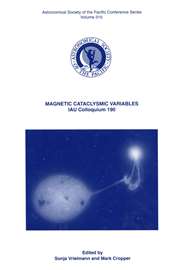No CrossRef data available.
Article contents
Physical Characteristics of Ionized Gaseous Nebulae*
Published online by Cambridge University Press: 15 February 2018
Extract
The chief advantages of the Space Telescope over conventional ground-based telescopes, namely, ability to observe ultraviolet radiation and high angular resolution, make it particularly valuable for research on gaseous nebulae. These objects are interesting not only in themselves, but also because they provide an opportunity to measure the abundances of the common light elements in the first two rows of the periodic table. H II regions are samples of interstellar matter from which stars are now forming in our galaxy, and in other galaxies. Planetary nebulae are objects approaching the end of their evolution as luminous stars, in which an outer shell has been thrown off and is returning to interstellar space. They represent one of the most prolific sources of mass return to interstellar matter at the present time in our galaxy.
- Type
- Research Article
- Information
- International Astronomical Union Colloquium , Volume 54: Scientific Research with the Space Telescope , 1979 , pp. 99 - 121
- Copyright
- Copyright © Marshall Space Flight Center 1979
Footnotes
Contributions from the Lick Observatory, No. 420


